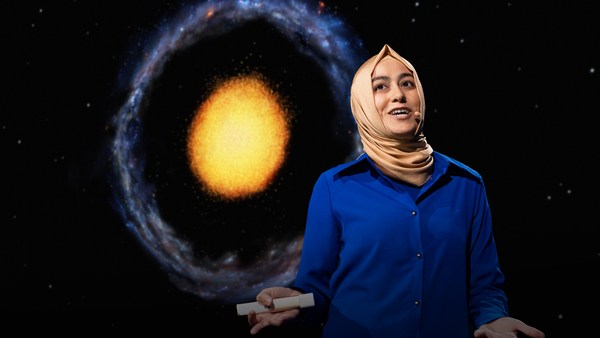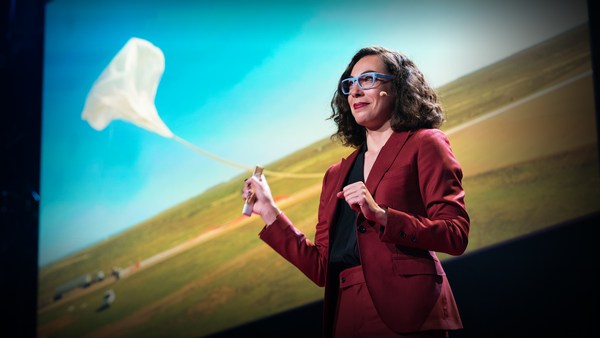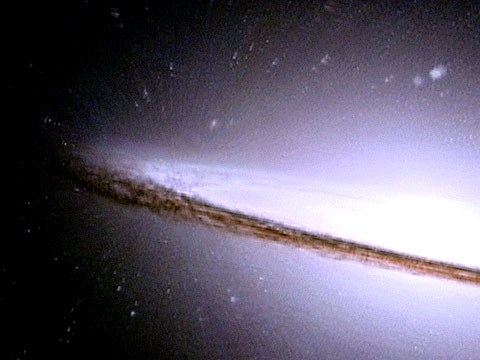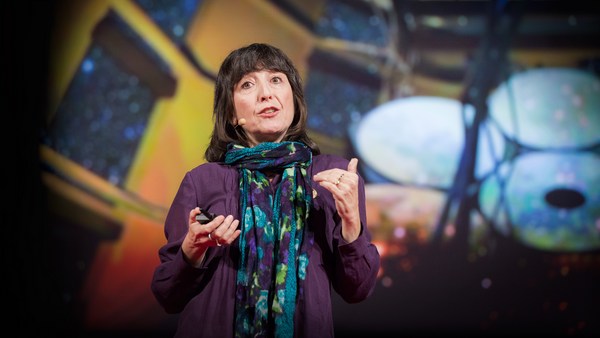When I was six, my father told me that I was made out of tiny cells filled with chromosomes that would control my fate. I thought, "That's amazing. There are so many mysterious things in there, and I want to know more.” I read about Galileo and Darwin, and I became a scientist.
At that time, hardly anything was known. We did not yet know that the chemical elements came from exploded stars, that everything you see around you was recycled from inside of stars. So we did not know we are recycled stars. But we set off to measure the Big Bang, and we measured the map of the cosmic microwave background radiation, using millimeter waves and it's the entire sky wrapped around on to an oval so you can see it. We see that there are hot and cold spots in this Big Bang material. Now we say, well, that’s because those were there in very, very beginning, who knows exactly why, but they led to the existence of galaxies, stars, planets and, eventually, people. No spots, no people. So it turned out to be important.
So then how did that work? What happened next? Well, we said let's take pictures. So, of course, we take pictures of the sky with the Hubble Space Telescope. This picture was taken around 1995, and it shows galaxies far, far, far away. It shows what you can get with the telescope that's about eight feet in diameter and can observe visible light. So we were thrilled to have this picture. And it shows thousands of galaxies. They were unable to include the most distant galaxies, the ones that would be as they were being born, so there are no baby pictures of galaxies in this picture. We needed to have an even bigger and more powerful telescope that could pick up the infrared light from the most distant universe that has been stretched out by the expansion of the universe. So we didn't know what we would find.
So astronomers wrote a book and they said, "Please build us an even more powerful telescope." And we did. This is the James Webb Space Telescope, you see a gigantic mirror, it's hexagonal, it's coated with gold so it reflects infrared light. It is 21 feet across. It is protected by a five-layer metalized plastic sunshade as large as a tennis court. This telescope is so large that it could not fit into the rocket without being folded up like origami. It's an incredible engineering accomplishment to be able to even conceive and build this telescope.
So we built it. And then we've launched it. It went up into space from French Guiana on Christmas morning, 2021. It was a perfect launch. The Arianespace company sent it straight to where we needed to go. So we think we can have 20 years of operational scientific observations with this great new telescope. And it took only two minutes to go through the tropical clouds up towards the vacuum of outer space.
Now I want to show you how it unfolded in outer space, this origami telescope. First we unfolded the solar panels. Then we unfold the transmitter antenna so we can talk back and forth. Then we unfold the panels that hold the great sunshade in place. This takes us actually two weeks in real life. You see it compressed here so we can show it to you. This is just a miracle of modern engineering, and it’s so complicated. And you'd say, is there any way you could have done this without this great telescope? And the answer seems to be no. You need a big telescope. It needs to be in outer space. It needs to be cold, so it doesn’t glow and emit its own infrared. And third is, being very carefully unrolled all by commands from here.
So you ask, how could you possibly make such a complicated thing work? Well, number one, practice, practice, practice, rehearse and test, fix it when it's not quite right. And then, of course, have two of everything, if you possibly can. And third, have arguments with all of your friends to say, is this really right? Can you think of anything that's a mistake that we might be making that we should fix before we launch it? So the last step is finally to unfold the telescope itself. And there it is in outer space, not quite ready to use because it's still warm and has not yet been focused. So we had to wait for several weeks for it to start to cool down to a low enough temperature that we could do the next steps. We send it to a place called Lagrange Point 2, about a million miles farther out from the Sun than we are. This is a place that moves around the Sun with us every year, so the telescope does not get any farther away. It is the only place that we can put a telescope where this is the setup, and you can have the one-sided umbrella that protects the telescope from the Sun and the Earth and the Moon.
So the next thing is, what did we see? We focused the telescope and took some pictures of the same star we looked at with the Webb. So the fuzzy picture is the Spitzer Space Telescope launched in 2003. The sharp picture is the new Webb telescope. We were so thrilled that it worked. We got a nice, sharp image of the star, and we can calculate now the sensitivity of this object, that if you were a bumblebee, a square centimeter object hovering at the distance of the Moon from the Earth, away from the telescope, we would be able to see you, both the sunlight you reflect and the heat you emit. So there are no bumblebees in space, but there's something out there that we don't know. And I'm so sure that we're going to get a great surprise from this telescope.
So I'll show you what we look at. Here is an example of a place where stars are being born as we speak. Now we know, more or less, that stars explode and produce dust, which goes and is recycled into new stars. This is a place where the recycling is happening. Stars are being born in this beautiful cloud of glowing gas and dust. On the left-hand side shows you what we see with visible light with the Hubble Space Telescope. The right-hand side shows you that you can begin to see through the dust with an infrared camera that we also have on the Hubble telescope. It's beautiful. Astronomers want to see inside and we will with the Webb telescope. We can look at everything in the solar system from Mars on out.
So this is a pretty interesting one, everybody knows Mars might be alive. What about Europa? Europa is a satellite of Jupiter. It has a liquid ocean covered with ice. We know because we sent a probe out there named after Galileo himself, and we saw this and took this picture. Now we know that there is water coming out from the cracks between the ice blocks and once in a while, they can be watched from here. And we are planning to send a probe to fly through the water jets and see if there might be any organic molecules in them. Is it alive? Well, maybe. We'll be watching this satellite with the Webb telescope as well. Farther on out in the solar system, we've been watching Titan. Titan is the only moon in the solar system that has oceans and lakes and rain and rivers and an atmosphere on the surface. It is so cold, though, that its liquid hydrocarbons, methane and ethane, that you would use for fuel here on Earth. So we'll be examining this with the Webb telescope and we'll be sending a probe out there to land with even a helicopter to go exploring. So is this a place that's interesting for life? Possibly.
People ask me all the time, are we sure that the kind we have here is the only kind? Well, maybe not. And if not, this is a good place to look because it's different, but it still has solids, liquids and gases, and it has a liquid hydrocarbon, which might be a possible solvent. We'll see.
Next thing we want to look at is, are there planets around other stars that might have life? So we will be looking in this way at small stars that have Earth-sized planets. When a planet goes in front of the star, it can block some starlight, some of the starlight goes through the atmosphere of the planet, if it has one, and on its way to our telescope, and we can analyze that and look for the chemistry of such an atmosphere. So, number one, does a little Earth-like planet out there have an atmosphere? Number two, does it have any molecules in the atmosphere? And number three, could they be water? Is there enough water out there so that there could be a liquid ocean? Well, maybe. We will find out and we'll tell you.
So are we alone? Well, I don't know. But we'll be going on after this project to even more powerful telescopes that can examine little Earths around stars like the Sun. And then we'll be able to say, "Really, really, are they like home?" And maybe yes. We will be telling you all about what we find out, beginning with our first scientific observations this summer. So please stay tuned. Astronomers travel with the speed of light and the speed of imagination.
(Applause)





